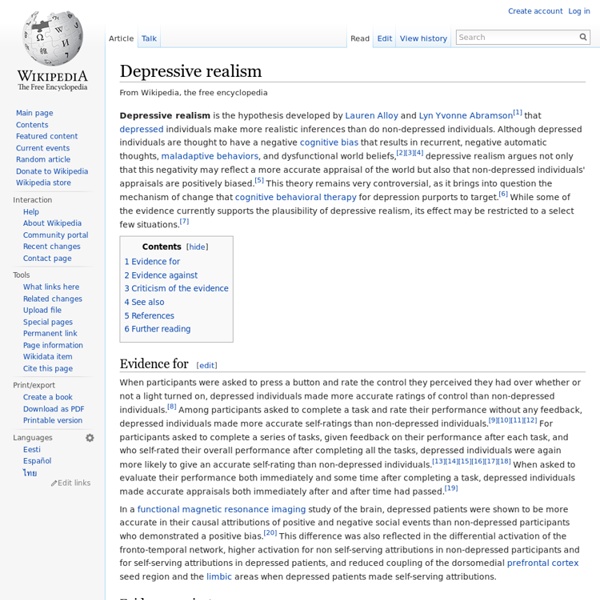



Stress and Depression Stress and depression have quite the cause and effect relationship. See how they continually fuel each other and what you can do to break the cycle. Transcript: Stress and depression have quite the relationship. That's because stress increases levels of the hormone... Stress and depression have quite the relationship. More » Rosenhan experiment Experiment to determine the validity of psychiatric diagnosis Rosenhan's study was done in eight parts. The first part involved the use of healthy associates or "pseudopatients" (three women and five men, including Rosenhan himself) who briefly feigned auditory hallucinations in an attempt to gain admission to 12 psychiatric hospitals in five states in the United States. All were admitted and diagnosed with psychiatric disorders. The second part of his study involved an offended hospital administration challenging Rosenhan to send pseudopatients to its facility, whom its staff would then detect. While listening to a lecture by R. In a 2019 popular book on Rosenhan by author Susannah Cahalan, The Great Pretender, the veracity and validity of the Rosenhan experiment has been questioned. Pseudopatient experiment[edit] Rosenhan and the other pseudopatients reported an overwhelming sense of dehumanization, severe invasion of privacy, and boredom while hospitalized. Impact and controversy[edit]
Metacognition Metacognition is defined as "cognition about cognition", or "knowing about knowing". It comes from the root word "meta", meaning beyond.[1] It can take many forms; it includes knowledge about when and how to use particular strategies for learning or for problem solving.[1] There are generally two components of metacognition: knowledge about cognition, and regulation of cognition.[2] Metamemory, defined as knowing about memory and mnemonic strategies, is an especially important form of metacognition.[3] Differences in metacognitive processing across cultures have not been widely studied, but could provide better outcomes in cross-cultural learning between teachers and students.[4] Some evolutionary psychologists hypothesize that metacognition is used as a survival tool, which would make metacognition the same across cultures.[4] Writings on metacognition can be traced back at least as far as De Anima and the Parva Naturalia of the Greek philosopher Aristotle.[5] Definitions[edit] [edit]
Positive Disintegration The Theory of Positive Disintegration (TPD) by Kazimierz Dąbrowski is a theory of personality development. Unlike mainstream psychology, Dąbrowski's theoretical framework views psychological tension and anxiety as necessary for growth. These "disintegrative" processes are therefore seen as "positive," whereas people who fail to go through positive disintegration may remain for their entire lives in a state of "primary integration." Advancing into disintegration and into the higher levels of development is predicated on having developmental potential, including overexcitabilities, above-average reactions to stimuli. Unlike some other theories of development such as Erikson's stages of psychosocial development, it is not assumed that even a majority of people progress through all levels. TPD is not a theory of stages, and levels do not correlate with age. Dąbrowski's theory[edit] Dąbrowski's theory of personality development emphasized several major features including: Overexcitability
5 Ways To Hack Your Brain Into Awesomeness Much of the brain is still mysterious to modern science, possibly because modern science itself is using brains to analyze it. There are probably secrets the brain simply doesn't want us to know. But by no means should that stop us from tinkering around in there, using somewhat questionable and possibly dangerous techniques to make our brains do what we want. We can't vouch for any of these, either their effectiveness or safety. #5. So you just picked up the night shift at your local McDonald's, you have class every morning at 8am and you have no idea how you're going to make it through the day without looking like a guy straight out of Dawn of the Dead, minus the blood... hopefully. "SLEEEEEEEEEP... uh... What if we told you there was a way to sleep for little more than two hours a day, and still feel more refreshed than taking a 12-hour siesta on a bed made entirely out of baby kitten fur? Holy Shit! We're pretty sure Kramer did this once on Seinfeld. How Does It Work? #4. #3. 1. 2. 3.
Cause of depression still eludes us, says neuroscientist We don't know what is wrong with the brains in people suffering from depression. On theory is that depression is connected to the amount of the neurotransmitter serotonin inside our brains. (Photo: Colourbox) Albert Gjedde, MD, is a neuroscientist and probes people's heads to see how their brains work. He is head of the Department of Neuroscience and Pharmacology at Copenhagen University. Gjedde explains we don't really know what is wrong with people suffering from depression but looking at the symptoms we get a good idea of where the fault could lie within the brain. Right now the eyes of neuroscientists are focused on the endogenous chemical in our bodies called serotonin, a neurotransmitter that regulates the intensity of our emotions, says Gjedde. Regardless of the emotion being happy or sad it would seem SSRI drugs dampens the experienced intensity of the emotion. People in treatment with SSRI dugs describe it as if the peak of their emotions are cut away. SSRIs mess up the cleanup
The Story of Stuff Self-efficacy Self-efficacy is the extent or strength of one's belief in one's own ability to complete tasks and reach goals.[1] Psychologists have studied self-efficacy from several perspectives, noting various paths in the development of self-efficacy; the dynamics of self-efficacy, and lack thereof, in many different settings; interactions between self-efficacy and self-concept; and habits of attribution that contribute to, or detract from, self-efficacy. This can be seen as the ability to persist and a person's ability to succeed with a task. As an example, self-efficacy directly relates to how long someone will stick to a workout regimen or a diet. Self-efficacy affects every area of human endeavor. Judge et al. (2002) argued the concepts of locus of control, neuroticism, generalized self-efficacy (which differs from Bandura's theory of self-efficacy) and self-esteem measured the same, single factor and demonstrated them to be related concepts.[3] Theoretical approaches[edit] Motivation 1. 2. 3.